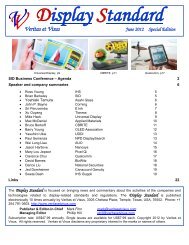Create successful ePaper yourself
Turn your PDF publications into a flip-book with our unique Google optimized e-Paper software.
<strong>Veritas</strong> <strong>et</strong> <strong>Visus</strong> <strong>Display</strong> <strong>Standard</strong> February 2009<br />
Another uncertainty about wh<strong>et</strong>her 16:9 is optimized versus 16:10 is that the comparison assumes existing diagonal<br />
sizes for 16:10 panels versus newly optimized diagonal sizes for 16:9 panels. It’s entirely possible that larger<br />
substrate sizes and new manufacturing technologies will enable 16:10 solutions to enjoy b<strong>et</strong>ter optimization at<br />
larger diagonal sizes. To be a fair comparison, the analysis should identify optimized substrate calculations for both<br />
16:10 and 16:9 solutions – rather than limiting the comparison to existing 16:10 panel sizes.<br />
The argument that 16:9 panels are optimal because of 16:9 content is accurate – but highly misleading. In fact, the<br />
fast majority of PC-content is b<strong>et</strong>ter suited for 16:10 solutions. One purpose for going to wide aspect ratios, for<br />
example, is to conveniently enable two-page viewing of documents on a single screen. A 16:10 screen enables this<br />
quite well, while a 16:9 screen forces the images to shrink to a much smaller portion of the screen. The tradeoffs<br />
here are shown in the below image. Note that these tradeoffs are worsened if we shift from l<strong>et</strong>ter-size documents to<br />
A4-size documents.<br />
On the left is a 16:10 display with facing pages; on the right, you can see that the lower height of a 16:9<br />
panel shrinks the size of the pages, while adding unused space on the right and left.<br />
The advent of TV tuners in notebook PCs, software titles in HD formats, and the increasing availability of HD-<br />
DVD/Blu-ray titles, may be a more prevalent usage model for the notebook PC than is the need to optimally see<br />
two pages side-by-side in a Word document.<br />
But it stills seems presumptuous to suggest that<br />
the primary purpose of PC displays is to watch<br />
Blu-ray titles and HDTV shows. And even if a<br />
PC is to be used primarily as an entertainment<br />
device, it’s worth noting that DVD titles (3:2<br />
format), classic movies, (4:3 format), and<br />
SDTV titles (4:3 format), are more optimally<br />
viewed on a 16:10 panel than on a 16:9 panel.<br />
And even considering Blu-ray, it should be<br />
noted that most movie titles are not presented<br />
at a 16:9 aspect ratio – but rather at an even<br />
wider aspect ratio, such that the claimed<br />
optimization for Blu-ray is relegated primarily<br />
to made-for-TV shows, and not Hollywood<br />
releases.<br />
It seems highly unlikely that the introduction<br />
of 16:9 panels will be d<strong>et</strong>erred at this point. It<br />
seems that the primary reason for this is that<br />
each of the LCD makers has decided to<br />
10<br />
The top image<br />
shows two side-by<br />
side pages in a<br />
Word format on a<br />
display with a<br />
16:10 aspect ratio.<br />
The bottom image<br />
shows how the loss<br />
of vertical height<br />
in a 16:9 aspect<br />
ratio reduces the<br />
size of the pages.<br />
It’s considerable<br />
and will certainly<br />
negatively impact<br />
the productivity<br />
gains afforded by<br />
wide aspect ratio<br />
solutions.






